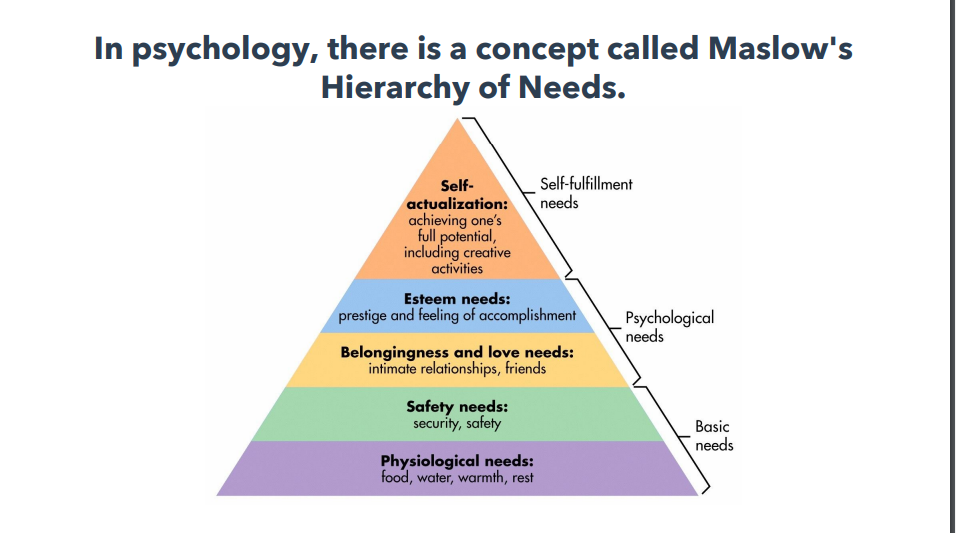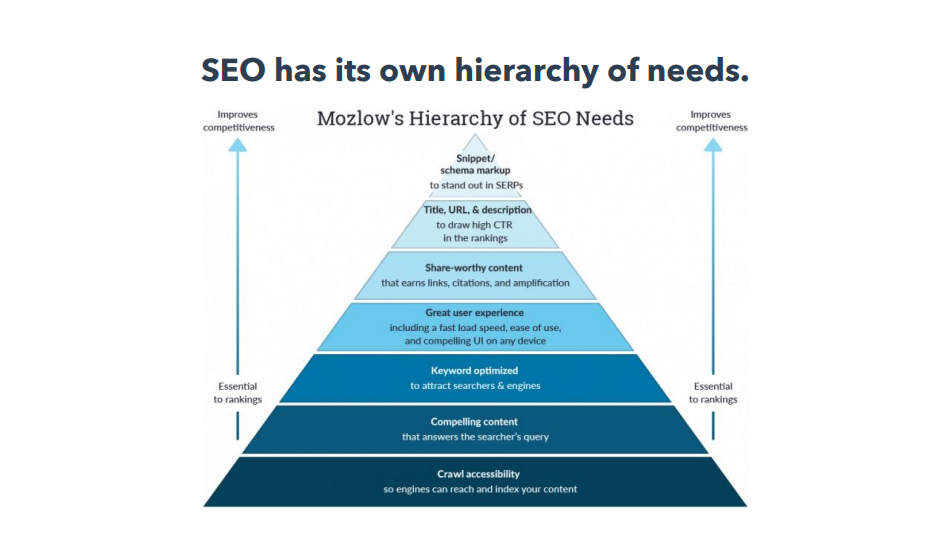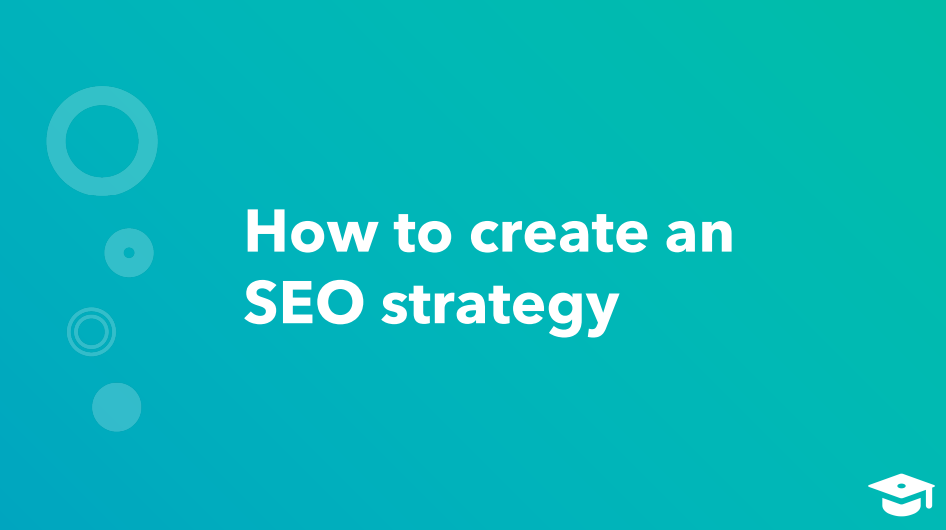In psychology, there is a concept called Maslow’s Hierarchy of Needs.
What is Maslow’s Hierarchy of Needs?
According to SimplyPsychology, Maslow’s Hierarchy of Needs is a motivational theory comprising a five-tier model of human needs, often depicted as levels within a pyramid. From the bottom of the hierarchy upwards, the needs are: physiological (food and clothing), safety (job security), love and belonging (friendship), self-esteem, and self-actualization. Needs lower on the pyramid must be satisfied before individuals can attend to needs at higher levels.

- SEO has its own hierarchy of needs. Source: Moz
- What is the Hierarchy of Needs for SEO?

This pyramid was developed by Moz, an industry-leading SEO software platform and thought leader. It’s a great way to think about SEO, and in particular, your SEO strategy. Just like with Maslow’s Hierarchy of Needs for human beings, you need to fuflfill the bottom tiers of the pyramid before you can move up to the higher tiers. When it comes to SEO, your site needs to be able to be crawled and indexed by search engines before you can start creating compelling content. And you need to have compelling content before you can start optimizing it for keywords — you get the idea. There are so many different SEO strategies and tactics out there, it’s hard to tell where you should start. This model is one way to figure out how to prioritize what you should be focusing on.
Your SEO strategy will depend on several factors.
- How established is your business online?
- What resources do you have to dedicate to SEO?
- What industry are you in?
A healthy SEO approach balances building relevance and building authority. That means creating high-quality, relevant content while also building high quality backlinks. Balancing how much time you focus on one versus the other depends on how much authority your website has right now. Take a moment to think about your business.Is your organization well-known, talked about, and linked to a lot online? If so, then you probably have pretty good search authority already. That means, when it comes to SEO, you won’t have to spend as much time building authority and can focus on defending your position. To do that, focus on serving up more and more relevant content to be discovered by Google. Creating more content will also, in turn, help you acquire more backlinks. Or, is your organization creating a lot of content but not getting many links?
Then don’t make the mistake of only focusing on content creation. If your website doesn’t have authority built up yet, then all the content you create isn’t going to get ranked as quickly as you’d like. Building authority is a combination of creating high-quality content and building links to it.
An SEO strategy has website goals and established KPIs. The next important piece of creating your SEO strategy is
determining goals for your website and establishing KPIs. By setting goals and putting numbers to those goals,
you’ll be able to figure out whether your SEO efforts are actually paying off. Many businesses will simply say, “We
want to rank #1 for this keyword,” but that isn’t quite enough.
What are your goals for your website?
- Do you want to increase organic traffic?
- Do you want to increase the number of leads from your website?
- Do you want to design a mobile-optimized website?
- Do you want to ensure your website is accessible for those with disabilities?
What are SMART goals?
SMART goals are specific, measurable, acheivable, realistic, and time-bound.
What are some SMART goals for SEO?
Make sure that you’re not setting vague or unrealistic goals for your SEO strategy. Goals should be clear and tied to business objectives. They should be achievable and realistic based on your website’s authority and the resources you’re dedicating to SEO. They should also be time-bound — this is especially important because SEO is a long game. It can take a while to start seeing results, so you have to be thoughtful and realistic about what you can acheive within a given timeframe.
The “measurable” piece of your SMART goals ties into KPIs.
What are KPIs?
Key Performance Indictors (KPIs) are the critical indicators of progress toward an intended result. (Source: KPI.org)
Choosing KPIs to measure is an important part of your SEO efforts.
Important indicators to consider include:
- Organic traffic
- Keyword ranking
- Conversion rate
- Bounce rate
- Page load time
- Backlinks built
Establish official KPIs for your website’s SEO strategy.
Once you know your goals for your website when it comes to SEO, you can establish your KPIs which will help you track toward success. Of course, the specific KPIs and numbers you determine will be based on your website, your goals, and your business. Here’s an example: “We want to increase organic traffic by 40% over the next 12 months.” This is a specific goal to achieve over a set timeframe with a specific metric to determine success. To learn more about establishing good KPIs, check out the resources for this video. Determine your SEO toolset to reach your goals. Once you’ve set your SMART goals and established your KPIs, it’s time to decide how to get there.
In SEO, you have a wide range of tools and strategies at your disposal. Depending on your goals and the resources you can dedicate to SEO, you should pick between 3 and 5 things to work on for a set period of time. For example, if your goal is to increase organic traffic to your website, your strategies to get there may include creating a series of blog posts for a set of target keywords, increasing your site speed by optimizing your images, or getting featured as a guest blogger on an authoritative website in your industry.
It’s okay to not do something if it’s not important for your users.
Focus on the user — don’t focus on “doing SEO” and checking boxes off for the sake of it. Focus your SEO strategy on what matters most to your users. Countless resources claim to tell you everything you “need” to do in order to optimize your website and create content that ranks highly in search engines. But, at the end of the day, simply performing tasks for the sake of checking a box on a checklist won’t solve the core problem of helping your users. Just like websites are specific to the individual business, SEO is specific to a business’ audience. This comes down to knowing your audience well and understanding what they’re searching for and wanting from your business.





















